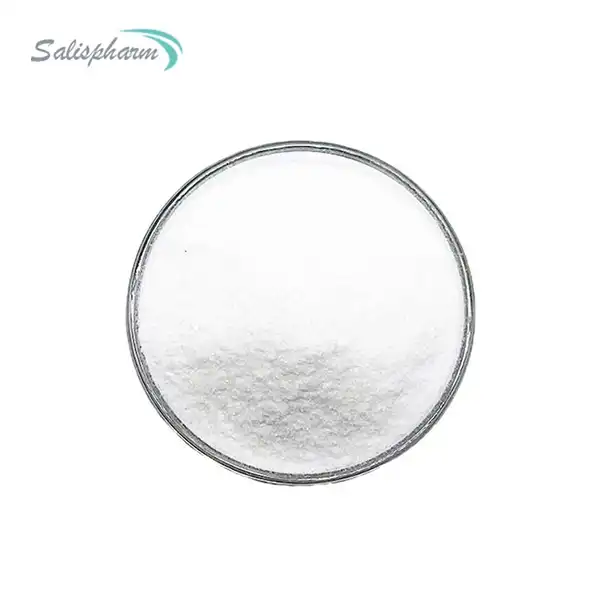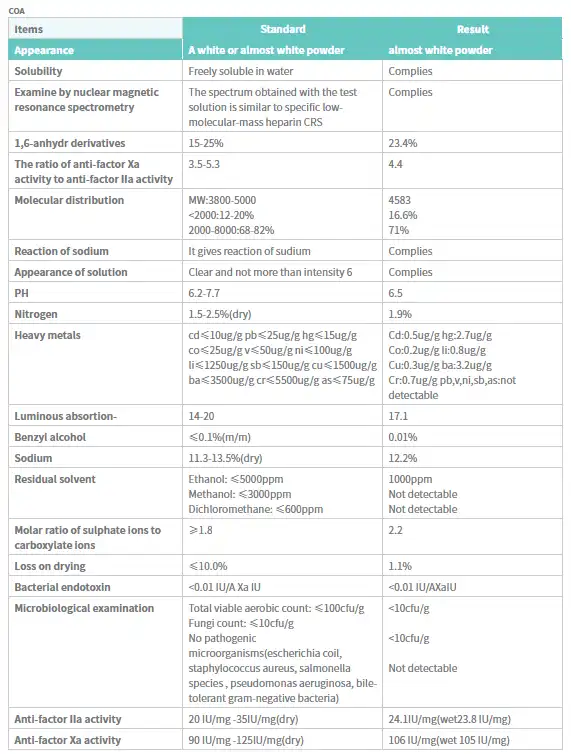Enoxaparin Sodium Powder (enoxaparin sodium), a widely used anticoagulant medication, plays a crucial role in preventing and treating blood clots within the human body. This low molecular weight heparin (LMWH) functions by inhibiting specific clotting factors in the blood, effectively reducing the risk of dangerous thromboembolic events. Understanding how enoxaparin sodium works is essential for healthcare professionals and patients alike, as it provides insight into its therapeutic benefits and potential side effects. In this comprehensive blog post, we will explore the mechanism of action of enoxaparin sodium, its primary indications, onset of action, and safety considerations during pregnancy. By delving into these aspects, we aim to provide a thorough understanding of this vital medication and its role in managing various medical conditions related to blood clotting.

What are the main indications for using enoxaparin?
Preventing Deep Vein Thrombosis (DVT)
Preventing deep vein thrombosis (DVT) is one of the main reasons why enoxaparin sodium powder is used. The development of blood clots in the deep veins, most commonly in the legs, is the hallmark of deep vein thrombosis (DVT), a dangerous medical disorder. In high-risk patients, such as those having orthopedic procedures like knee or hip replacement, enoxaparin is especially useful in preventing deep vein thrombosis (DVT). Blood clots are formed by clotting factors, which the medicine blocks. These factors include factor Xa and thrombin. By decreasing the probability of clot formation, enoxaparin sodium powder aids in the maintenance of normal blood flow and lessens the incidence of DVT-related consequences, some of which can be fatal.
Treating Acute Coronary Syndrome
Another crucial indication for enoxaparin sodium powder is in the treatment of acute coronary syndrome (ACS). Inadequate blood supply to the heart can cause a variety of symptoms, such as unstable angina and myocardial infarction, which are all included in acute coronary syndrome (ACS). To lessen the likelihood of future cardiac episodes and stop any more clot development, enoxaparin is given in these cases. By preventing blood clots, enoxaparin sodium powder keeps coronary arteries open, which means more oxygenated blood can reach the heart. At the time immediately following a sudden cardiac event, when the likelihood of further clot formation is greatest, this is of the utmost importance. Enoxaparin is essential in improving ACS patient outcomes by efficiently controlling the coagulation cascade.
Managing Pulmonary Embolism
Enoxaparin sodium powder is also indicated for the management of pulmonary embolism (PE), a potentially life-threatening condition where blood clots lodge in the pulmonary arteries, obstructing blood flow to the lungs. In cases of PE, enoxaparin is used both as an initial treatment and for long-term prevention of recurrent events. Acute PE patients can benefit from this medicine because of how quickly it inhibits coagulation factors. In addition, enoxaparin sodium powder's predictable pharmacokinetics make it possible to consistently provide anticoagulation, an essential factor in avoiding the development of new clots. By maintaining an optimal balance in the coagulation system, enoxaparin helps reduce the risk of PE recurrence and associated complications, ultimately improving patient outcomes in this serious condition.
How long does it take for enoxaparin to start working?
Immediate Onset of Action
Enoxaparin sodium powder demonstrates a remarkably rapid onset of action, making it an invaluable tool in urgent anticoagulation scenarios. The anticoagulant effects of the medicine start to kick in 20 to 30 minutes after subcutaneous injection. Because of its unusual chemical structure, enoxaparin is able to be absorbed and distributed rapidly throughout the body, leading to its rapid action. Prompt anticoagulation can greatly affect patient outcomes, making the rapid commencement of treatment especially important in acute conditions like the first management of deep vein thrombosis or pulmonary embolism. Enoxaparin sodium powder is a trusted anticoagulant that healthcare personnel can use to intervene quickly in life-threatening situations.
Peak Anticoagulant Activity
While the initial effects of enoxaparin sodium powder are observed quickly, the medication reaches its peak anticoagulant activity approximately 3 to 5 hours after administration. This peak activity corresponds to the maximum inhibition of factor Xa, which is a key component in the blood clotting cascade. The optimal therapeutic benefit of enoxaparin can be achieved through accurate dose and timing of administration, made possible by its predictable pharmacokinetics. The anticoagulant effects of enoxaparin sodium powder last for a long time, usually up to 12 hours or more, even though they achieve peak activity within a few hours. For patients who need to be on anticoagulant therapy all the time, this extended duration of action makes dosing regimens easier and helps the medicine avoid thrombotic events.
Steady-State Concentration
For patients receiving multiple doses of enoxaparin sodium powder, such as those on long-term anticoagulation therapy, it typically takes about 3 to 4 days to achieve a steady-state concentration in the blood. The anticoagulant effects remain constant over time because the rate of medication administration and removal is balanced at this steady-state. In situations calling for extended anticoagulation, reaching steady-state is especially important for keeping therapeutic enoxaparin levels appropriate. Healthcare providers monitor patients closely during this initial period to ensure the desired anticoagulant effect is achieved and maintained. The predictable pharmacokinetics of enoxaparin sodium powder at steady-state allow for more straightforward management of long-term anticoagulation therapy, improving patient compliance and outcomes.
Can enoxaparin be used during pregnancy?
Safety Profile in Pregnancy
Because pregnant women who are at risk of thromboembolic events may require anticoagulation, the use of enoxaparin sodium powder during pregnancy is a highly relevant clinical issue. Enoxaparin has a generally good safety profile for usage during pregnancy, according to both scientific studies and clinical experience. Noxaparin, unlike warfarin and other anticoagulants, does not pass the placental barrier because of its high molecular weight. This quality greatly lessens the possibility of the drug coming into close contact with the developing baby. The safety profile of enoxaparin sodium powder in pregnancy is further supported by numerous studies that have not demonstrated an increased risk of congenital malformations or other adverse fetal outcomes when used appropriately under medical supervision.
Indications for Use in Pregnancy
Enoxaparin sodium powder finds several important indications for use during pregnancy. One of the primary applications is in the prevention and treatment of venous thromboembolism (VTE) in pregnant women who are at high risk. This includes women with a history of previous VTE, those with inherited thrombophilias, or those with other risk factors such as obesity or prolonged immobility. Additionally, enoxaparin is often used in pregnant women with mechanical heart valves, where anticoagulation is critical to prevent valve thrombosis. The predictable pharmacokinetics and the ability to monitor anti-Xa levels make enoxaparin sodium powder a preferred choice for managing these complex clinical scenarios during pregnancy, ensuring both maternal and fetal well-being.
Dosing Considerations in Pregnancy
When using enoxaparin sodium powder during pregnancy, careful consideration must be given to dosing regimens. Dosage adjustments may be necessary because of changes in enoxaparin pharmacokinetics caused by physiological changes that occur during pregnancy. The glomerular filtration rate and blood volume both rise during pregnancy, which may improve medication clearance. Consequently, higher doses or more frequent administration of enoxaparin may be required to maintain therapeutic anticoagulation levels. Healthcare providers often monitor anti-Xa levels closely in pregnant women receiving enoxaparin to ensure optimal dosing. It's also important to note that the transition from enoxaparin to other anticoagulants or cessation of therapy should be carefully managed, particularly as the time of delivery approaches, to balance the risks of thrombosis and bleeding during the peripartum period.
Conclusion
Enoxaparin sodium is a versatile and effective anticoagulant with a wide range of clinical applications. Its rapid onset of action, predictable pharmacokinetics, and favorable safety profile make it an invaluable tool in preventing and treating thromboembolic disorders. From managing acute coronary syndromes to providing long-term anticoagulation during pregnancy, enoxaparin sodium powder continues to play a crucial role in modern medicine. As research advances, we can expect further refinements in its use, potentially expanding its applications and improving patient outcomes across various medical disciplines.
At Xi'an Salis Biological Co., Ltd., we are committed to producing high-quality APIs, including enoxaparin sodium powder, to meet the growing demands of the pharmaceutical industry. Our state-of-the-art facilities and rigorous quality control processes ensure that we deliver products of the highest standard. For more information about our enoxaparin sodium powder or other API products, please contact us at lea_slsbio@163.com,WhatsApp+86 13193326505.

FAQ
Q: What is the primary mechanism of action for enoxaparin sodium?
A: Enoxaparin sodium primarily works by inhibiting factor Xa and thrombin in the blood clotting cascade, thus preventing clot formation.
Q: How quickly does enoxaparin start working after administration?
A: Enoxaparin begins to exert its anticoagulant effects within 20 to 30 minutes of subcutaneous administration.
Q: Is enoxaparin safe to use during pregnancy?
A: Yes, enoxaparin is generally considered safe for use during pregnancy as it does not cross the placental barrier.
Q: How long does it take to reach steady-state concentration with enoxaparin?
A: It typically takes about 3 to 4 days of regular dosing to achieve steady-state concentration of enoxaparin in the blood.
Q: Can enoxaparin be used to treat acute coronary syndrome?
A: Yes, enoxaparin is indicated for the treatment of acute coronary syndrome, including unstable angina and myocardial infarction.
References
1. Garcia DA, Baglin TP, Weitz JI, Samama MM. Parenteral anticoagulants: Antithrombotic Therapy and Prevention of Thrombosis, 9th ed: American College of Chest Physicians Evidence-Based Clinical Practice Guidelines. Chest. 2012;141(2 Suppl):e24S-e43S.
2. Merli GJ, Groce JB. Pharmacological and clinical differences between low-molecular-weight heparins: implications for prescribing practice and therapeutic interchange. P T. 2010;35(2):95-105.
3. Bates SM, Greer IA, Middeldorp S, Veenstra DL, Prabulos AM, Vandvik PO. VTE, thrombophilia, antithrombotic therapy, and pregnancy: Antithrombotic Therapy and Prevention of Thrombosis, 9th ed: American College of Chest Physicians Evidence-Based Clinical Practice Guidelines. Chest. 2012;141(2 Suppl):e691S-e736S.
4. Hirsh J, Bauer KA, Donati MB, Gould M, Samama MM, Weitz JI. Parenteral anticoagulants: American College of Chest Physicians Evidence-Based Clinical Practice Guidelines (8th Edition). Chest. 2008;133(6 Suppl):141S-159S.
5. Fareed J, Hoppensteadt D, Walenga J, Iqbal O, Ma Q, Jeske W, Sheikh T. Pharmacodynamic and pharmacokinetic properties of enoxaparin : implications for clinical practice. Clin Pharmacokinet. 2003;42(12):1043-57.
6. Blann AD, Lip GY. Venous thromboembolism. BMJ. 2006;332(7535):215-219.

